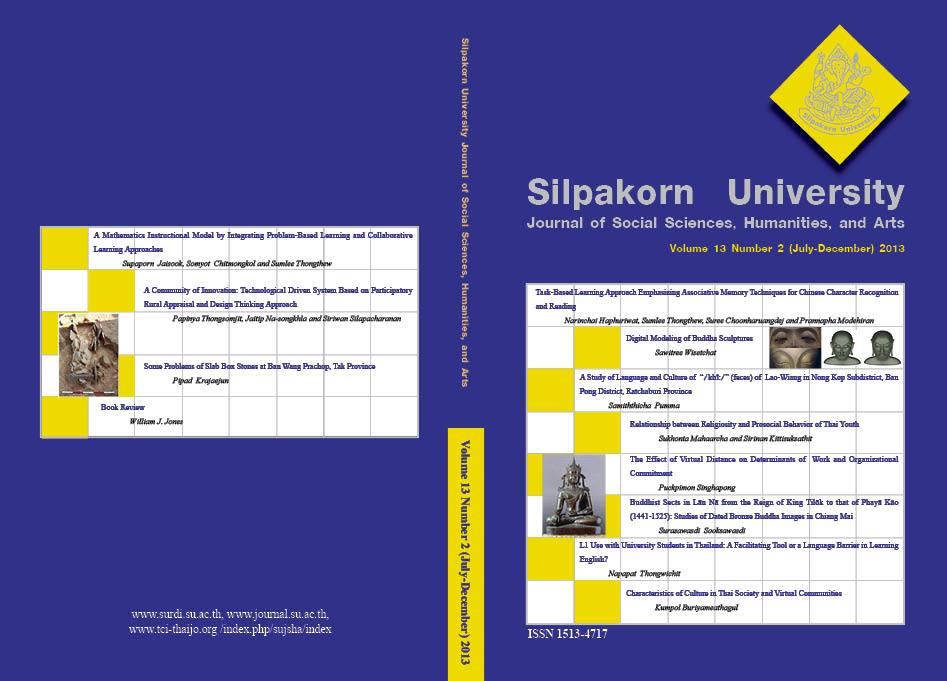Digital Modeling of Buddha Sculptures
Main Article Content
Abstract
The Sukhothai Buddha (1238-1438 CE) a distinct sculptural style developed which is still characteristic of Thai Sculpture Style today. TheSukhothai style inherited some artistic elements from its precursors, yet evolved through a remarkable process of refinement and invention. This study considers the visualization of this evolution. Conventionally, styles are analyzed and compared through written descriptions with reference to still images. It is difficult, however, to visually appreciate the evolution of style by such means. A new technique is adapted from digital character animation to assist in the visualization of style differences and to illustrate style evolution. By modeling sculptures of different styles as variations ona common shape, blend animation allows one style to change smoothly into another by interpolation. The viewer can now better appreciate style differences, not by shifting gaze from one to another, but by watching onebecome another, wherein their differences attract visual attention.
Downloads
Article Details
All rights reserved. Apart from citations for the purposes of research, private study, or criticism and review,no part of this publication may be reproduced, stored or transmitted in any other form without prior written permission by the publisher.
References
Beier, T. and Neely, S. (1992) Feature-based image metamorphosis, Computer Graphics 26(2): 35-42.
Brown, R. L. (1996) The Dvaravati Wheels of Law and the Indianization of South East Asia. Leiden: E. J.
Brill. Catmull, E. and Clark, J. (1978) Recursively generated B-Spline surfaces on arbitrary topological meshes. Computer Aided Design 10(6): 350-355.
Deng, Z. and Noh, J. (2008) Computer facial animation: A survey. In Data-Diven 3D Facial Animation, edited by Deng, Z. and Neumann, U., pp. 1-28. London: Springer-Verlag.
Fisher, R. E. (1993) Buddhist Art and Architecture. London: Thames and Hudson.
Gosling, B. (2004) Origins of Thai art. Weatherhill, Trumbull, CT.
Kraus, K. (2007) Photogrammetry: Geometry from Images and Laser Scans, 2nd ed., Berlin: Walter de Gruyter GmbH & Co.
Krishan, Y. (1996) The Buddha Image. It’s Origins and Development. New Delhi: Munshiram Manoharlal Publishers.
Leidy, D. P. (2008) The Art of Buddhism: An Introduction to its History and Meaning. Boston: Shambhala Publications.
Pixologic (2011) Brush Portal [Online URL:www.pixologic.com/zbrush] accessed on September 2011.
Rowland, Jr., B. (1963) The Evolution of the Buddha image. New York: Asia House Gallery Publication/Harry N. Abrams, Inc.
Siegel, A. F. and Benson, R. H. (1982) A Robust comparison of biological shapes. Biometrics 38: 341-350.
Thompson, D. W. (1917) On Growth and Form. Cambridge Universit Press, Cambridge. [Online URL:openlibrary.org/books/OL6604798M/On_growth_and_form].
Van Beek, S. and Tettoni, L. I. (1991) The Arts of Thailand. Thames and Hudson, London, p. 114.
Wisetchat, S. (2011) “Sukhothai: The Evolution of a Distinctly Thai Sculptural Style”. M.Phil. Thesis. Glasgow School of Art, Digital Design Studio, University of Glasgow, Glasgow, Scotland.
Wisetchat, S. (2013) “Visualizing the Evolution of the Sukhothai Buddha”. Southeast Asian Studies 2(3). (in press).
Woodward, H. W., Jr. (1997) The Sacred Sculpture of Thailand. Bangkok: River Books.


